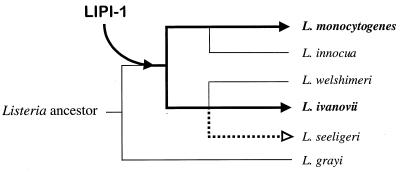FIG. 9.
Evolution of the central virulence gene cluster (LIPI-1) in the genus Listeria. The presence of LIPI-1 at the same chromosomal position in various species belonging to distinct evolutionary branches of the genus suggests that the virulence gene cluster was acquired before speciation (see text for details). Thick lines indicate the evolutionary pathway followed by LIPI-1; solid arrows indicate conservation of a functional LIPI-1 (in L. monocytogenes and L. ivanovii), whereas the dotted lines with an open arrowhead indicate functional corruption of the virulence gene cluster (in L. seeligeri). L. innocua and L. welshimeri presumably arose by excision of LIPI-1 in the corresponding evolutionary branches. The dendrogram is a schematic reconstruction of the phylogeny of Listeria according to references 98 and 579. (Adapted from reference 670 with permission of the publisher.)

